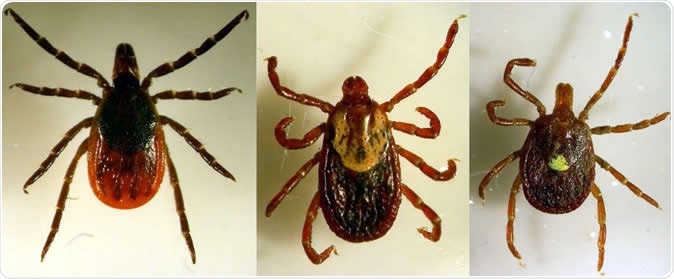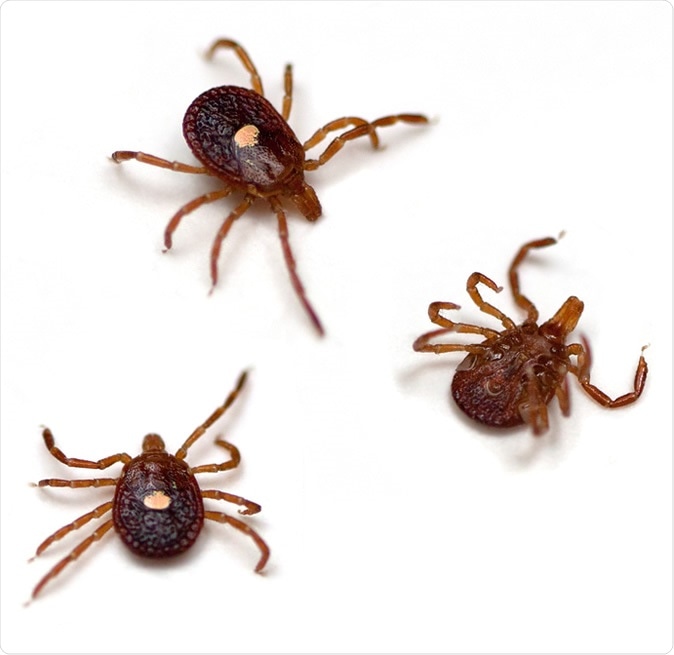A new study published in the journal mBio reports that ticks carry many more disease-causing agents than just those responsible for causing Lyme disease.
All over the world, tick-borne illness is a public danger. In the US, tick-borne infections have more than doubled over the period 2004-2016 to the current number of over 48,000. Their severity may range from subclinical to fatal, and they mostly affect the very young and the old. Some are transmitted by the bite of a tick, but others also through blood transfusion. This latter category can seriously harm those who are already sick.
In the current study, scientists collected ticks at multiple sites in Suffolk county, Long Island, a location for seven tick-borne diseases. They looked at over 1,600 ticks using molecular biology techniques. They detected the presence of the Lyme disease agent (Borrelia burgdorferi) in well over half of the adult Ixodes scapularis, or deer ticks, but the most abundant pathogen species was R. buchneri, a non-pathogenic strain which probably contributes immensely to the tick’s metabolism.

Three primary human-biting tick species present on Long Island were examined in this study. Left -- blacklegged tick also known as the deer tick, middle -- the American dog tick, right -- the lone star tick. Image Credit: Santiago Sanchez-Vicente, Stony Brook University
Next in frequency came the agents that cause babesiosis (Babesia microti) and anaplasmosis (Anaplasma phagocytophilum), each in 14% of adult ticks. Babesia is found in 15% of immature ticks too. Other important pathogens found in I. scapularis include Borrelia miyamotoi and the deer tick virus (Powassan virus), found only in adult ticks and at low levels.
Polymicrobial infections by a single tick bite
The current study discovered multiple agents in 25% of these ticks, which means that a single bite can cause several different illnesses. Most commonly, in 9% of ticks, B. burgdorferi and B. microti were found together. However, B. microti is treated with antiparasitic drugs but not B. burgdorferi, whereas beta-lactam antibiotics clear the latter. In 7%, B. burgdorferi and A. phagocytophilum co-existed. These can both be treated with doxycycline, a single drug. However, this drug is typically not given to young children, a large patient group in Lyme disease. Infections occurred mostly in spring and fall and involved triple infections with the three species named above more frequently than dual infections of any two agents.
The study also found that one very aggressive species of tick called the lone star tick (Amblyomma americanum), originally from the southern US, had now moved outward to occupy the territory around Long Island too. In fact this has now become the most abundant tick species here. This tick causes the bacterial disease called Ehrlichiosis, which is more common in elderly or immunocompromised patients. It also causes southern tick-associated rash illness (STARI), and a new type of meat allergy syndrome which could be due to the tick itself, rather than a pathogen carried by it. Its nymph forms cause scratching and itching in the infected skin. This territorial expansion could be due to the changing climate. The fact that Long Island is an island could also affect the number of rodents, which in turn favors the infection of juvenile ticks with one or more pathogens.

Lone Star Ticks (Amblyomma americanum). Image Credit: Melinda Fawver / Shutterstock
Rickettsieae comprise the largest bacterial population in two of the three tick species. R. ricketsii which causes Rocky Mountain spotted fever is carried by the American dog tick, Dermacentor variabilis, but other rickettsieae, like R. buchneri, R. amblyommatis (found abundantly in A. americanum) and R. montanensis (which may cause a very similar illness) are abundant in I. scapularis and lone star ticks respectively.
Changing patterns of disease
As ticks take over new territory and push out competing species, the pattern of prevalence of tick-borne disease could change significantly in the future. Secondly, these pathogens will interact with each other, including genetic changes, to form a new microbiome which favors the growth of some species. Some pathogens are found in the midgut, others intracellularly. The Powassan virus is rapidly transmissible whereas A. phagocytophilum and B. miyamotoi can enter the host within 24 hours of tick attachment. All these may further promote infections with rapidly acquired organisms, for instance, as the others require a longer attachment time before they can be transmitted. The lack of interbacterial effector and bacterial immunity could allow the pathogens to develop shared tolerance which favors their survival.
B. burgdorferi and B. microti are in a 4:1 ratio, similar to the ratio of Lyme disease to Babesiosis. Lyme diease is about 15 times more common than anaplasmosis, but B. burgdorferi is only about 4 times more common than A. phagocytophilum – perhaps due to less severe clinical features of anaplasmosis which were not brought to medical attntion
Changes in clinical practice
The study concludes by pointing out the possibility of multiple agents being transmitted by a single tick bite which must be considered while treating tick-borne disease. Ehrlichia affect monocytes, A. phagocytophilum infect neutrophils and B. microti red cells. These are therefore transmissible by blood and blood products as well. The important thing is that the presence of multiple infections passed on by the same bite can make the diagnosis more difficult even while increasing the seriousness of the disease, according to researcher Jorge Benach. A variety of antibiotics may need to be administered, for instance, to deal with the different agents, making treatment more costly and potentially more dangerous.
The study was published on September 10, 2019.
Journal reference:
Polymicrobial nature of tick-borne diseases. Santiago Sanchez-Vicente, Teresa Tagliafierro, James L. Coleman, Jorge L. Benach, & Rafal Tokarz. mBio. DOI: 10.1128/mBio.02055-19, http://dx.doi.org/10.1128/mBio.02055-19